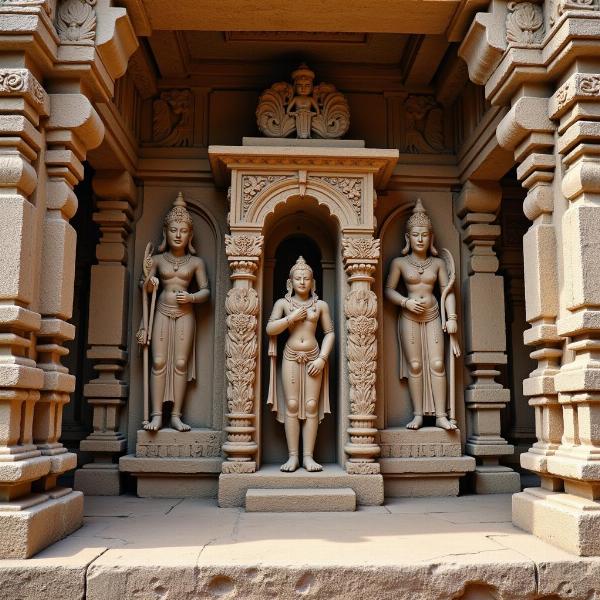Understanding the meaning and cultural significance of “stonecutter” in Hindi offers a fascinating glimpse into Indian history, traditions, and language. This guide explores the various nuances of the term, its historical context, and its relevance in modern India. We’ll delve into the different Hindi words used for stonecutter, their etymology, and their usage in various contexts.
The Art of Stone Carving in India
India boasts a rich heritage of stone carving, dating back centuries. From intricate temple sculptures to majestic monuments, the skill and artistry of stonecutters have shaped the country’s cultural landscape.  Intricate stone carvings adorning a temple in India, showcasing the skill of Indian stonecutters.
Intricate stone carvings adorning a temple in India, showcasing the skill of Indian stonecutters.
Historical Significance of Stonecutters
Historically, stonecutters held a prominent position in Indian society. Their expertise was crucial in constructing magnificent temples, palaces, and forts. These artisans were not merely laborers but skilled craftsmen who transformed raw stone into works of art, contributing significantly to India’s architectural heritage.
Modern Relevance of Stonecutting
Even today, stonecutting remains a vital craft in India, albeit with evolving techniques and applications. While traditional methods are still practiced, modern tools and technologies have also been incorporated. Stonecutters continue to play a role in preserving and restoring historical monuments, as well as creating contemporary works of art.
Stonecutter in Hindi: Various Terms and Their Meanings
The Hindi language offers several terms for “stonecutter,” each with its specific connotations. Understanding these nuances is crucial for accurate translation and interpretation.
Pathar Katne Wala (पत्थर काटने वाला)
This is a general term for “stonecutter,” literally translating to “stone cutting person.” It’s commonly used to refer to anyone involved in cutting or shaping stone.
Sangtarash (संगतराश)
Sangtarash carries a more artistic connotation, often used to describe a skilled sculptor who works with stone. It emphasizes the craftsmanship and artistic ability involved in stone carving.
Shilpkar (शिल्पकार)
Shilpkar is a broader term for “artisan” or “craftsman,” which can also encompass stonecutters, especially those involved in creating artistic or intricate works.
Regional Variations
It’s important to note that regional variations exist within Hindi. Different dialects may use specific terms for “stonecutter,” reflecting local traditions and linguistic nuances.
What Does a Stonecutter Do?
The work of a stonecutter involves a variety of tasks, ranging from quarrying and shaping raw stone to carving intricate designs. They may specialize in specific types of stone or techniques, contributing to the diverse world of stone carving.
Tools and Techniques
Traditional stonecutting tools include chisels, hammers, and mallets. Modern tools like power saws and grinders are also used, particularly for larger projects or mass production.
The Future of Stonecutting in India
While traditional stonecutting faces challenges in the face of modernization, it continues to thrive, adapting to changing demands and embracing new technologies. The artistry and cultural significance of stonecutting ensure its continued relevance in India’s artistic and architectural landscape.
Conclusion
Understanding the meaning of “stonecutter” in Hindi provides insight into a rich cultural tradition. From the historical significance of sangtarash to the modern applications of stone carving, the craft continues to shape India’s artistic and architectural heritage.
FAQ
- What is the most common Hindi word for stonecutter? Pathar katne wala (पत्थर काटने वाला) is the most common term.
- What is the difference between sangtarash and pathar katne wala? Sangtarash implies a higher level of artistic skill, while pathar katne wala is a more general term.
- Are traditional stonecutting techniques still used in India? Yes, traditional methods are still practiced alongside modern technologies.
- What is the future of stonecutting in India? The craft is adapting to modern demands and integrating new technologies, ensuring its continued relevance.
- Where can I find examples of Indian stone carving? Numerous temples, monuments, and museums across India showcase the art of stone carving.
- What tools do stonecutters use? Traditional tools include chisels and hammers, while modern tools like power saws are also used.
- Is stonecutting a respected profession in India? Historically, stonecutters held a prominent position, and the craft continues to be valued today.
Meaning-Hindi.in offers expert translation services in Hindi and other languages, specializing in business, legal, technical, website localization, educational, and specialized translation. Our team understands the cultural nuances of the Hindi language and can provide accurate and reliable translations for your specific needs. Whether you need to translate business documents or technical manuals, our expert linguists can deliver high-quality translations that meet your requirements. Contact us today for a quote: Email: [email protected], Phone: +91 11-4502-7584. Meaning-Hindi.in is your trusted partner for all your Hindi translation needs.